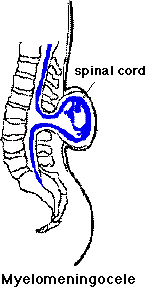|
|
|
|
|
|
| PRAY FOR A MIRACLE
SUNDAY, MAY 6, 2001 Information about Stephanie and Spina Bifida.
This information is not to educate on spina bifida as a birth defect. Many children run and play with no evidence to the onlooker that he or she has spina bifida. There are others who depend on respirators to breath. Many have severe mental retardation. This is just Stephanie's journey with Spina Bifida.
 Myelomeningocele is the most serious and common of the two forms of cystic spina bifida. The visible signs are a sac or cyst, rather like a large blister on the back, covered by a thin layer of skin. The cyst not only contains tissue and cerebro-spinal fluid but also nerves and part of the spinal cord. The spinal cord is damaged and there is always some paralysis and loss of sensation below the damaged region. The amount of disability depends on where the spina bifida is and the amount of nerve damage involved. Stephanie's disability involves almost total paralysis from her waist down, week abdomen, bowel and bladder problems, leg deformities, hip dislocations and circulatory problems within her legs. Treatment (From the National Institute of Neurological Disorders and Stroke) There is no cure for Spina Bifida because the nerve tissue cannot be replaced or repaired. Treatment for the variety of effects of Spina Bifida may include surgery, medication, and physiotherapy. Many individuals with Spina Bifida will need assistive devices such as braces, crutches, or wheelchairs. Ongoing therapy, medical care, and/or surgical treatments may be necessary to prevent and manage complications throughout the individual's life. Stephanie to date, has had seven surgeries and extensive therapy.
Hydrocephalus?(Commonly known as water on the brain) A watery fluid know as cerebro-spinal
fluid (or CSF for short) is constantly being produced inside each of the four
spaces (or ventricles) inside the brain. The CSF flows from one ventricle to the
next and then down the spinal cord. From here is is absorbed into the
bloodstream and the pressure within the brain is kept within a fairly narrow
range. With hydrocephalus, the pathway is obstructed and the fluid accumulates
in the ventricles inside the brain. The majority of babies
born with spina bifida have hydrocephalus. The increase in pressure due to this
can also compress the abnormal parts of the brain even further. Without
treatment, more brain damage and death can occur. How is Hydrocephalus Treated?The usual treatment is to insert a shunting device. It is important to note that this does not 'cure' the hydrocephalus and damage to the brain tissue remains. Shunting controls the pressure by draining excess CSF, so preventing the condition becoming worse. Symptoms caused by raised pressure usually improve but other problems of brain damage can remain. Stephanie's shunt device was inserted when she was just a few days old.
Arnold Chiari Malformation Chiari is a condition in which the cerebellum (back parts of the brain), slips into the space where the spinal cord travels into the skull. This 'crowding' can result in a restriction in the flow of cerebral spinal fluid from the spine into the brain and vice-versa. The systems of Arnold Chiari are many and vary from person to person with some showing no systems. The systems that Stephanie has are: Loss of vision- Stephanie has a vision of 2100 Motor Skills Dysfunction- Although Stephanie has made great improvement, the dysfunction with fine motor skills interferes greatly with everyday life. Simple things like doing a button is impossible at this point. At 8 years old she has developed few self help skills. Swallowing-Stephanie was three years old before she could eat or drink anything that wasn't the consistency of pudding. Although her diet is full, caution still has to be taken. Sinus/Mucous Problems-Stephanie has an over production of mucous. Under normal circumstances Stephanie does fine. At times when we normally produce more mucous (colds, crying) Stephanie produces it in excess which results in vomiting to clear her wind pipe. Gag Reflex Problems-This only presents a problem with carrying out oral hygiene. Difficulty Reading Text-Stephanie struggles in school period but reading and writing is slow going for her. Sleep Apnea- The lapse in breathing can be numerous times a night and up to 20 seconds at a time but she always starts breathing again on her own.
My Inspiration (An Essay written by Stephanie's brother) see what other have wrote in my guest book Stephanie's Home Church (Fountain of Life)
|